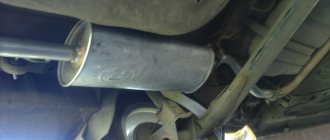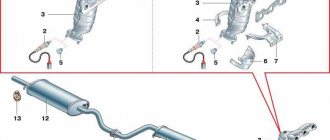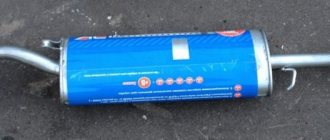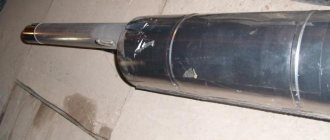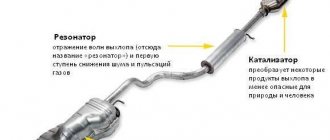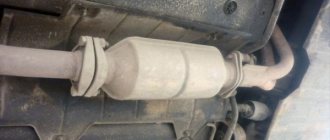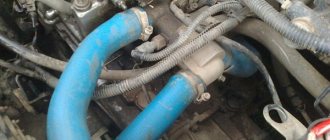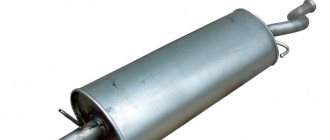Print this article Font size 16
There is no need to worry; replacing a muffler on a VAZ 2110 is not at all a regular job that will have to be done systematically. Replacing the exhaust system is performed in several situations:
- The muffler begins to make a loud noise;
- Muffler elements burn out;
- Connecting pipes break.
The sound of a burnt out muffler.
On a VAZ 2110, you can replace the muffler with your own hands, which will allow you to significantly save on the services of a service station.
The exhaust system of the VAZ 2110 includes a downpipe (pants), a neutralizer, a resonator and a main muffler.
Photo of the new muffler on the VAZ 2110
Today we will tell you about replacing the muffler, as well as the resonator.
Exhaust system VAZ 2110
Dimensions of the VAZ 2110 Resonator
The exhaust system consists of several parts, each of which plays an important role. These include the exhaust pipe, catalyst, resonator and the muffler itself. The main functions it performs are noise reduction and reduction in the emission of harmful gases. Also, there is often a corrugation on the receiving pipe, designed to reduce vibration. A malfunction of any part of the exhaust system can affect the condition of the entire car and many other parts in particular, so it is necessary to regularly diagnose this element of the car.
Installation of a new neutralizer
If you decide to modify your car, you can install the Stinger exhaust system on the VAZ-2110. It is more reliable and advanced than stock.
All work is carried out the same way. The neutralizer is installed as follows:
- Install the neutralizer, and then put on the bolts. This must be done very carefully, making half a turn, no more.
- When tightening, you must first tighten the bolts that secure the neutralizer to the resonator. The last to be tightened are the bolts securing the converter to the exhaust pipe.
How to repair a muffler
If your car's muffler requires repair or complete replacement, it is not recommended to do this work yourself, since there is a high risk that you will only worsen the condition of the exhaust system, and possibly the entire vehicle as a whole. In order to prevent such a situation, contact only specialized car services. In our car service center, qualified specialists with the necessary competence in the field of working with exhaust systems will competently diagnose the exhaust system of your car, and, if necessary, repair or install a new muffler in the shortest possible time.
If you encounter any malfunction in the exhaust system and you need to diagnose it, repair it or replace the muffler, then our salon specialists will be happy to help you with this, since we carry out all types of this work!
1200 rub. for the photo report
We pay for photo reports on car repairs. Earnings from 10,000 rubles/month.
Write:
The muffler resonator is a part of the exhaust system whose task is to dampen low-frequency sounds arising from engine operation. It will be useful for every car enthusiast to know where the resonator is located and what possible problems he will have to face during its service. A breakdown of the exhaust pipe resonator is not critical, but it can cause a lot of inconvenience not only to the driver, but also to those around him. We will talk about all this in this material about how to eliminate problems that have arisen, how to dismantle and install the unit, as well as how to make a resonator with your own hands
Lada Kalina Sedan Red Devil › Logbook › Replacing the resonator with a Grantovsky one for cheap
Today we will talk about how the corrugation on the resonator fell back and how it was repaired in a cheap way) Probably about a month ago the car “finally” had a voice and it began to sound pleasant, but the exhaust sounds, alas, appeared not from behind, but in the middle of the car... In addition, the interior began to smell of exhaust gases, which is not good... At first there were two versions of what was wrong with the car, either the resonator corrugation died or a hole appeared in the pipe itself... Having stopped at the service pit and looked under the car , it became clear that the corrugation told me “Come on, goodbye!”...
Next, I needed to look at how I mount the resonator to the spider (well, or to the catalyst, whichever is more convenient for you to call it), so as not to make a mistake when buying another one, because... There were two versions of resonators for Kalina - with 2 holes for mounting and without corrugation and with 3 holes with corrugation. My resonator was with 3 holes and corrugated, but I can assume that the exhaust system here is no longer original, because From the factory, the car is listed according to the documents as Euro-2, and as I understand it, there should be 2 holes and no corrugation, I could of course be wrong, but if anyone is really good at this, then correct me in the comments, at the same time I’ll at least know for sure )
Then the search began for a resonator with 3 holes and corrugation!) Here you could go down two roads - buy a new resonator or buy a used one... I first started looking for a used resonator for Kalina on the vastness of a well-known site with advertisements, but, a resonator no one sells for Kalina, but there are 3 resonators for sale from Granta, with the statement that they are suitable for both Kalina and Datsun... Then I went to the Lada Detail auto parts store to find out the cost of a resonator for Kalina, and there I they announced the price for it at 2800 rubles... Before turning around and leaving, I decided to clarify whether the resonator from Granta was suitable for Kalina, to which I was told that there are different fastenings and different bends of the pipe, that is, they are not interchangeable... Okay , I went home and started googling again, on the websites of other stores I found information that the same resonator fits both Kalina and Grant... Hmm... I started looking for entries on Drive2, has anyone encountered this, and is the resonator suitable from Granta? And yes, I found such entries in the BZ! Next, I again headed to the vastness of the site with advertisements, where I found 3 options - for 700, for 800 and for 1000 rubles. I decided to do everything cheaply, but with high quality) That’s why the first thing I went to look at was a used resonator from Granta, according to the seller, with a mileage of 7000 km and for 700 rubles
:
This resonator was in the area, like all the others for sale! Having arrived and examined the resonator, I realized that I had to take it!
Source of the article: https://www.drive2.ru/l/573512138069377670/
Purpose of the resonator
First, let's figure out what a resonator is for . As mentioned above, it is part of the exhaust system of a car engine. Its main function is to dampen low-frequency sounds that arise during the exhaust process of gases and their entry into the gas exhaust system. There are two reasons why noise occurs in it:
- sound from expansion of gases;
- noise from vibration of exhaust system elements.
Along with a muffler, the tasks of a car resonator include reducing the speed of movement of exhaust gases. This becomes possible thanks to a physical law, according to which gases that move quickly in a narrow pipe, when they enter a large volume, lose their speed and, accordingly, energy. In the gas exhaust system, the resonator is located in front of the main muffler, being, in fact, the first link in the sound muffling chain of the exhaust system. That is, its main tasks are preliminary noise reduction and balancing of exhaust gas flow pulsations.
Some car owners call it the “middle muffler” (due to its physical location approximately in the middle of the bottom of the car) or the “second muffler.” However, this is not true because the exhaust system resonator and muffler have different operating principles.
The resonator of the car exhaust system also performs the function of freeing the engine exhaust from exhaust gases and creating uniform pressure in it. This ensures minimal resistance to the movement of exhaust gases, and it is possible to use almost all the useful engine power.
Resonator device
Structurally, the resonator consists of a perforated (drilled along the entire length within the device) pipe placed in a metal casing. The design also has a throttle hole designed to increase the efficiency of damping wave vibrations in the pipe. The internal cavity of the resonator is divided into two or more unequal parts by partitions located in a transverse plane to the pipe. Also, more modern exhaust resonators are designed with thermal insulation and/or sound insulation (often the same material) located under the housing and designed to reduce its temperature and/or sounds emanating from the device.
Internal structure of the resonator
The internal cavities have an unequal volume in order to ensure periodic narrowing and expansion of the flow of exhaust gases, which in turn equalizes their uneven pulsation. That is, each chamber has its own resonant frequency. In addition, they have a slight offset relative to the axis of the body. This is necessary to achieve a change in the direction of the exhaust flow. And internal perforation on the pipe is needed to dampen the large amplitude of sound waves that produce gases.
Problems with the resonator
Like any part, a car resonator periodically fails. After all, it passes through exhaust gases having a temperature of several hundred degrees Celsius. And in combination with the aggressive chemical elements contained in the escaping gas mixture, this leads to gradual burning of the metal parts of the system.
The main signs of resonator failure are:
- Deterioration of the muffler and exhaust system . This is manifested by increased sound coming from the exhaust pipe, especially low frequency sounds (roar).
- The appearance of exhaust gases from under the bottom of the car . This is a clear sign of depressurization of the resonator or other parts of the gas exhaust system.
- The presence of a characteristic rattling metallic sound from the resonator . It appears due to the fact that one (or more) of the internal components of the device burns out. Usually in such cases he “hangs out” or breaks away and rumbles in one of the cells.
- Significant drop in engine power . Due to a malfunction, the throughput of the resonator decreases significantly, so it dampens uneven pulsations of exhaust gases worse or not at all. And this gives feedback on the deterioration of the power unit.
If you encounter one or more of the above signs of a resonator malfunction, you need to inspect its operation as quickly as possible
How to check the catalyst?
Engine power depends on the condition of the catalyst. If there are characteristic symptoms of a breakdown, you should definitely check it. This can be done in light (by dismantling) and for back pressure or CO content without removing Read more
Shoots the silencer
Does your car engine need to shoot at the muffler? Then it’s worth checking the ignition system, fuel supply or timing marks. Find out the reasons and how to get rid of popping sounds from the muffler Read more
Replacing the VAZ 2110 resonator
Repairing the exhaust system or replacing the muffler on a VAZ 2110 most often involves replacing the resonator, since welding does not take long to solve the problem of burnout. The main task is to quickly remove the resonator Read more
The result of the work
In order for the muffler to last a couple of thousand km longer, before installation it is necessary to fill it with a special liquid that prevents corrosion from forming. The muffler must be twisted in different directions so that the liquid completely lubricates the internal space.
As a result of replacing the muffler, the sound of a running engine will not frighten passers-by, alarm drivers or infuriate traffic police inspectors. And comfort.
Whose muffler is better to buy for Lada Kalina?
Lada Kalina or VAZ of the 1117-1119 family is not as common in our country as classic models or models of earlier versions, but they are still quite common on our roads. For this model, you can find a fairly wide range of exhaust system spare parts on the Ukrainian market. Today we will focus on the questions: how much does a muffler cost for Kalina, how much does a resonator cost for Kalina, which muffler is better to choose for Kalina?
The most important criteria that we will focus on will be the cost of the spare part, as well as the ratio of quality and price. The cheapness of spare parts is not always the optimal solution, although here it is clear: “the stingy pays twice!”
Which muffler should I buy for Kalina (VAZ 1117 - VAZ 1119)?
Fundamentally, on the Ukrainian market you can buy two types of spare parts for the VAZ 1117-1119 muffler system. These are parts made of ordinary black steel, as well as products with anti-corrosion coating. You should consider which muffler is best installed on Kalina (station wagon, sedan or hatchback).
Checking the resonator
When identifying the problems listed above, every motorist should know how to check the resonator . This will not only normalize the operation of the engine and exhaust system, but also increase the comfort of using the car, including for the people around you.
To check, you will need an inspection hole (if you don’t have one, you can jack up the car). Diagnosis is made using visual inspection. During the process, it is necessary to carefully examine the integrity of both the device itself and the pipes connected to it (especially at their joints).
A clear sign of a problem is the formation of condensation in the cooling resonator, after which it begins to drip to the ground. This means that its body has lost its tightness and must be repaired, or better yet, replaced. You can check for condensation after some time, when you turn off the engine (to allow the resonator body to cool). Note! Some car enthusiasts, when making resonators on their own, specially drill a hole in its body to remove moisture . Therefore, if you bought a car with a similar resonator, then this testing method will not work for you.
Also, the integrity of the resonator body can be determined by the presence of exhaust gases leaving it. This also indicates depressurization and the need to replace it. This fact can be checked with the car engine running by looking under the bottom. To be sure, you can ask an assistant to “turn on the gas” at the same time so that more exhaust gases pass through the system. Also, suspicion of depressurization is caused by the appearance of smoke from under the bottom of the car while driving or when parked with the engine running.
Lada Kalina Hatchback 1.4 16V › Logbook › Resonator replacement or wild adventures…
Good day to all. Let's talk about the exhaust system. Somehow my resonator burned out, after examining it (the can was still alive, the pipes were also good, but the can itself burned out), I decided to try to boil it. An acquaintance helped me with welding and so I drove for about another year. Afterwards, it burned out again in almost the same place, and the can had already begun to fall apart... In general, it was decided to change it, but there were still 2 weeks before the vacation) Therefore, in order not to frighten others during these 2 weeks, I had to patch up this hole a little. I covered it with cement for the exhaust system, wrapped it with aluminum tape on top and reinforced it with wire for reliability. But such dendrofecal repair was enough for about 10 days,
so for a little less than a week I drove in “sport mode”, just like these boys. I replaced the resonator simply by jacking up the car.
Oh, how annoying it is to drill out the catalytic converter studs, and even while lying down, when it’s all right before your eyes. But more on that a little later... I bought a VAZ 1118-19 EURO-3 aluminized resonator. "SVD". As it turned out later, the diameter of this SVD is 7 mm smaller than the original one (I don’t remember exactly), here’s another problem for you. Now at the junction between the muffler and the resonator there will be different diameters, which means problems with the connection are guaranteed... Previously, the muffler-resonator mount was redone:
On the new resonator we had to saw off the widening for the ring. For 2 years the coupling looked very bad:
Therefore, I decided to try treating the new coupling with a cold galvanizing compound.
I don’t know how much it will help, but I’ll find out. At the same time I processed the welds on the new resonator:
I disconnected the muffler and looked at the condition of the catalyst studs:
It became clear that I would have to drill it out. First I ground off the remaining bolts:
I cut off the remaining studs with a hacksaw:
and started drilling... After killing several hours, dulling several drills (cheap drills) and even trying a concrete drill with a Pobedit (or whatever it is) head, I still couldn’t win.) Having drilled one hole
I went to bed half angry. The next day I went to the store, wanted to buy a hardened drill, but there weren’t any there, so out of desperation I had to buy 3 regular Dewalt metal drills (diameters 3; 5.5; 8). The drills are quite expensive, but the quality is high. Fearing that these drills would also become dull, I tried not to press too hard when I was drilling, and so on for half an hour, but there was little use and I, freaking out, began to press at low speeds. And lo and behold, after a couple of minutes the first hole was 3 mm in diameter, then 5.5 mm and finally the required diameter was 8 mm. And literally within half an hour I drilled all 3 holes. Uhh, this is tough...
I screwed the resonator to the catalyst, used copper nuts for the exhaust pipe from a VAZ 2108, so that it would be easier to unscrew it the next time it was replaced.
I installed 2, but the third one didn’t fit because of the sensor, so I installed a self-locking one
Next is the muffler-resonator connection. So that this “SVD”... In order to somehow increase the diameter of the resonator pipe, we had to pervert the sealant:
And still I had trouble connecting the muffler to the resonator. These couplings are simply not designed to connect such different diameters. At first nothing came out of the joint, but a year later it started, when I put my hand down I felt that it was only cutting in one place, this is already good, I’ll try to coat it with sealant closer to summer. Well, that seems to be all, thank you all for your attention and bye!
Source of the article: https://www.drive2.ru/l/523905197081100368/
Types of automotive resonators
When choosing an exhaust system resonator, you need to know what types they are and what materials they are made from. Currently, automotive resonators made of aluminized steel and stainless steel . The former are distinguished by their low price, but short service life. Their body is made of thin steel, coated with aluminum on top to prevent corrosion. However, this anti-corrosion composition is not durable. Therefore, we do not recommend that you buy an exhaust resonator made of aluminized steel. It is better to buy a car resonator made of stainless steel. This material has a smoother surface (that is, creates a minimum of turbulence in the system), and is also more resistant when working under extreme temperatures.
Differences between spare parts
Today on the market you can find an extremely large number of Kalina mufflers, the prices of which are too low. However, you need to understand how much an original spare part costs (to do this, just go to the official Lada website) in order to be able to distinguish between components made by hand. They will most likely last several times less than the original and, quite possibly, due to non-compliance with the technology, will even pose a danger to the life and health of the driver. Spare parts for model 1118 differ in the following parameters:
- material. The original spare part is made of aluminum or stainless steel. A product made of stainless steel will be quite difficult to find; they are often made to order. If the muffler is made of any other material, it is a fake;
- price. The cost of the original component is estimated at a thousand rubles or more, while fakes can cost less;
- weight. For the original it is higher than for the fake, since the real model is equipped with thicker walls and also contains a soundproofing layer;
The difference between the Kalina sedan, station wagon and hatchback muffler is that in the first and second models the product tube is curved, and the last model is equipped with a muffler with straight inlet and outlet pipes.
DIY resonator
Before designing and assembling a resonator of your own design, you need to understand one simple thing. The thicker the material from which the exhaust system is made (including the resonator), the more effective the fight against vibrations and resulting noise will be. It is for this reason that the exhaust manifold, which is the first to receive gases from the cylinder head, has such an impressive weight.
However, when choosing a material, you should not overdo it and choose too massive blanks. Otherwise, the mass of the resonator will be significant, and this will affect the dynamic characteristics of the car and the load on its chassis.
There are a number of reasons why car owners make their own exhaust resonators. One of them is to reduce the noise that a standard factory muffler produces. Usually, for this purpose, an additional resonator is installed in the exhaust system. The second reason is the manufacture and installation of a direct-flow car resonator . Its features are as follows:
- reduction in engine power loss (actually insignificant, about 5.10%);
- changing the sound background of the engine and exhaust system (for lovers of low sound).
Manufacturers
Parts for Lada 1118 can be purchased from the following manufacturers:
- Lada . The AL category factory part has all the necessary characteristics for installation. It is made of aluminized steel, and the addition of silicon to the mixture only better protects the product from rust and improves resistance to temperature changes and aggressive chemical compounds. You can purchase such a part from official representatives of the company or in company stores;
Factory muffler for Lada Kalina
- BalakovoRezinoTechnika. This Russian manufacturer, in addition to spare parts for domestic cars (VAZ, KamAZ, GAZ), is engaged in the production of rubber products as its main activity;
- Auto kit . This company operates in St. Petersburg and produces, in particular, roll-up mufflers for the VAZ 1118;
- Melitopol plant of automobile and tractor mufflers "UTAS". Engaged in the manufacture of exhaust gas systems. The company's assortment includes 150 types of products, including intake and exhaust pipes, mufflers for the VAZ 1118. The products produced are excellent for Moskvich, VAZ, MTZ, GAZ, ZAZ and many other brands of vehicles;
- SKS . The company's products meet the declared characteristics and have the required thickness and standard size. It is made, like the factory components, from aluminized steel, and can be installed along with the factory components of Kalina 1118;
Removing and installing the resonator
Many motorists are interested in a natural question - how to remove the resonator ? The answer to this question will vary depending on the brand of car. However, in general, the algorithm is simple and will be approximately as follows:
- it is necessary to disconnect the resonator pipes at the points of their connection with the exhaust gas removal system (front, on the engine or catalyst side, and at the rear, on the muffler side);
- remove the resonator from its suspensions, with the help of which it is attached to the bottom of the car;
- dismantle the resonator with its pipes.
How to replace a Renault Logan resonator
Installing a new device is done in the reverse order. When removing the resonator, it is important not to damage the O-rings that connect its pipes to the rest of the exhaust system.
As an example, we present to your attention two video instructions demonstrating the replacement of the resonator on popular Renault Logan cars and front-wheel drive VAZ 2110, VAZ 2111, VAZ 2112, VAZ 2114, VAZ 2115, Kalina, Priore, Grante.
Finally
Partial or complete failure of the car exhaust system resonator is not a critical failure . Diagnosing a resonator failure is not difficult even for an inexperienced car owner. This is indicated by a loss of power, the spread of exhaust gases under the bottom and/or into the cabin, and an increase in background noise when the engine is running. Please note that the car can be used case, however, we still recommend that you do not delay repairs, since driving with a burnt-out resonator can lead to failure of other elements of the vehicle’s exhaust system.
Publication date: August 25, 2016. Category: Automotive equipment.
When any mechanism operates, a characteristic noise is created, and when it comes to a gasoline internal combustion engine, the “sound effects” are distinguished by increased volume, which causes a lot of discomfort both to the driver himself and to other road users, as well as pedestrians. As you know, the role of a noise absorber is played by a standard muffler, which is part of the exhaust system, but few people know why a resonator is needed, which is also an important component of this unit.
From the name it is obvious that this part is responsible for resonating the sound streams that arise during the operation of the car engine. Simply put, the resonator dampens sound vibrations as exhaust gases exit the combustion chamber. Let's take a closer look at the device and features of this element.
Replacing pants
Trousers
The exhaust pipe, also called pants (due to its appearance), is attached to the manifold using studs and nuts. Its fixation with the neutralizer is carried out by a spring-loaded connection.
- Remove the exhaust pipe, paying special attention to its attachment to the manifold. Studs are used here, not bolts. They are screwed into the manifold, and connecting nuts are screwed onto them.
- If the pin is damaged, it will be extremely difficult to replace it. Therefore, it is important to try to keep the old one intact and safe.
- Treat the nuts with WD40, a product we all know. This will allow you to avoid using excessive force and keep the studs intact. If that doesn't work, the studs are drilled out. The process is complex, lengthy, and requires experience and skill.
- There is a gasket between the manifold and the pants that needs to be replaced. Also install a new converter o-ring.
- Now firmly press the exhaust pipe using the nuts. To do this you will need to compress the gasket.
- Then tighten the bolts of the spring-loaded connection with the neutralizer of your VAZ 2110.
As you noticed, there is nothing complicated in this work. Each element is quite easily dismantled and a new one is installed in its place. Just be careful, act carefully and consistently. Plus, of course, do not forget about the importance of the quality of new parts. Buy only good spare parts that will ensure long-term and efficient service of the exhaust system on your VAZ 2110.
How does a resonator work?
Externally, the resonator is very similar to a muffler, which is why it is often called a small or additional muffler. This rather complex part consists of a large number of layers, and from them it performs its function.
When looking at the cross-section of the resonator, it becomes obvious that it really is very similar to a standard car muffler. In more detail:
- The design of the resonator consists of several chambers separated by a special mesh, due to which there is a constant narrowing and expansion of gas flows, which flow in sharp jerks. The resonator allows you to level out this pulsation, creating uniform flows.
- Due to the displacement of these chambers, the direction of movement of the exhaust gas flow changes, which also allows smoothing out uneven pulsations.
- The frequency of exhaust gases is also suppressed thanks to internal perforations. It allows you to reduce the volume of exhaust sounds.
Types of exhaust system resonators
Additional mufflers are divided into 2 types depending on the engines with which they are used:
- For two-stroke engines. If such a motor is installed on the car, then it is necessary to use a resonator. The fact is that the absence of this device will lead to increased gasoline consumption, the elimination of unburned fuel and gas removal. The speed of the car will decrease.
- For four strokes. In this case, the resonator becomes more of a problem than a solution. If you dismantle it, this will lead to an increase in engine power by 15%.
The resonators also differ in design. There are standard monoblock products, but increasingly, car enthusiasts prefer combined models. They consist of two parts: a classic design equipped with a pipe and partitions and a chamber filled with a special noise-absorbing material (most often basalt fiber). Combined resonators are considered more modern and efficient.
In addition, small mufflers come in short, medium and long. They also differ in volume. It is worth noting that the effectiveness of this device directly depends on this indicator. If the volume is not enough, then when you press the gas sharply, the noise will increase greatly.
Small mufflers are made from different materials. Inexpensive models are made from aluminized steel; by and large, this is ordinary steel with a thin layer of aluminum applied to it. This allows you to protect the product from corrosion for some time.
Healthy! The most durable and high-quality products are considered to be those made of stainless steel with a double body.
Since the exhaust system, including the resonator, is constantly exposed to high temperatures, this leads to frequent malfunctions. In order to avoid an unpleasant surprise, it is recommended to periodically diagnose this component of the car and identify possible “symptoms” of malfunctions.
When failure and replacement of Kalina corrugation
An experienced craftsman will name the reasons for the failure of the corrugation after only briefly examining it.
Dents, punctures, gaps in the housing with rupture of the outer layers of the braid - most likely, the corrugation received mechanical damage during movement. The body can be torn open by a stone, a bump, a hole in the road, or anything that the bottom of a car can run into.
Rust, breaks at the joints of the part with the manifold and pipe. The joints, as motorists have already warned, are the weak side of the muffler corrugation on Kalina. It itself is made of stainless steel, but welds that are not coated with anti-corrosion material, from dirt, dust, moisture, reagents, etc., crumble quickly.
Traces of burning through the corrugation. Due to constant exhaust pressure at high temperatures, the braid layers may someday burn out. This almost always happens if the honeycomb of the catalytic converter is clogged, when the pressure increases many times. The body bristles with brittle and torn layers of braiding and loses its seal.
Violation of corrugation fixation. The clamps can simply rot, and part of the weight of the pipe will be distributed onto the corrugation, which will lead to its rupture.
Signs of a malfunctioning muffler resonator
Any malfunction of the resonator can lead to a decrease in motor power and also affect the noise level. Most often, car enthusiasts encounter the following signs of deterioration in the performance of the additional muffler:
- The volume of the exhaust system sound has increased.
- A metallic rattling noise appeared in the place where the resonator was installed. The reason for this may be that one of the internal parts of the resonator has burned through.
- Engine power began to drop. This is a consequence of the reduced capacity of the additional muffler.
If you notice one or more characteristic signs, repair or replace the resonator.
Repairing the exhaust system resonator
The most common problem with almost all resonators is the appearance of holes and rust. In this case, it is not necessary to go to a car repair shop or buy a new part; it is easier and cheaper to repair the resonator yourself, for this:
- Cut a tin plate larger than the hole created.
- Sand the area where you plan to install the patch with sandpaper.
- Drill several holes on the additional muffler and the patch itself to secure it.
- Using putty and hardener, fix the patch to the resonator.
- Screw the screws into the holes made.
It is not recommended to start the car right away, as the putty must harden.
Thanks to this repair, you will be able to use the small muffler for another couple of years. However, if the breakdown turns out to be more serious, then it will be impossible to do without replacing the failed part.
Algorithm of actions when replacing a muffler corrugation
A simplified procedure for replacing the corrugation looks like this:
- The muffler is removed.
- The old corrugation is cut down.
- On the new corrugation, cuts are made at the joints (if necessary), and the old seams on the pipe are cleaned.
- The new part is installed in place of the old one.
- Welding is carried out (first spot welding to fix the part, then full welding around the entire circumference).
- The weld seam is treated with an anti-corrosion agent.
- The muffler is installed in place and secured with hangers.
Changing the muffler resonator with your own hands
To change the resonator without the help of specialists you will need:
- the resonator itself;
- a set of gaskets, fasteners, as well as a sealing connecting ring for a new small muffler;
- anti-corrosion spray (for example, WD-40);
- keys for 17.
After you have prepared everything you need, drive the car onto an overpass or inspection hole. Use the handbrake or parking brake, or simply put the car in gear. Further:
- Treat the mounting points of the resonator to the muffler and the bolts themselves with an anti-corrosion compound.
- Remove the old resonator. If it is difficult to remove, repeat the anticorrosive treatment. Most likely, the bolts will have to be torn off in any case, but there is a chance to save them.
- Disconnect the clamp that secures the resonator to the muffler.
- Separate the pipes and get rid of the metal seal.
- Loosen the resonator mounting nuts that connect it to the converter or manifold.
- While lifting the resonator, carefully remove the suspension cushions from the brackets.
- Completely unscrew the mounting nuts and remove the small muffler.
- Install the new resonator in reverse order.
Healthy! After you have connected the resonator to the mufflers, be sure to make sure that there are no cracks or gaps at the joints.
